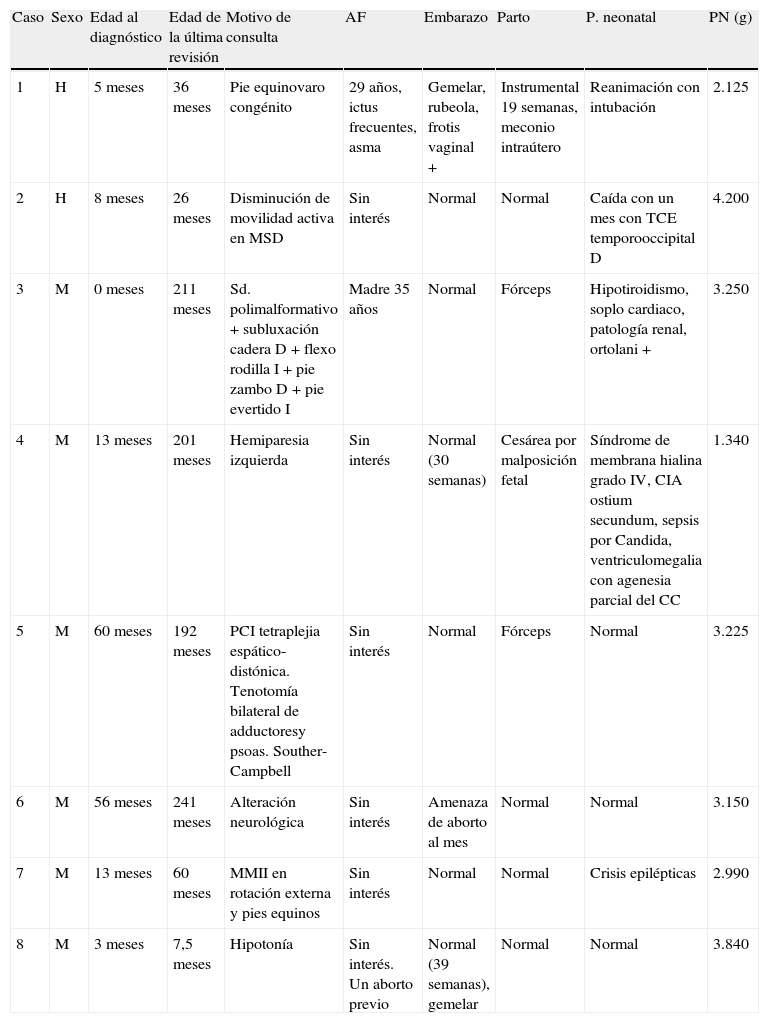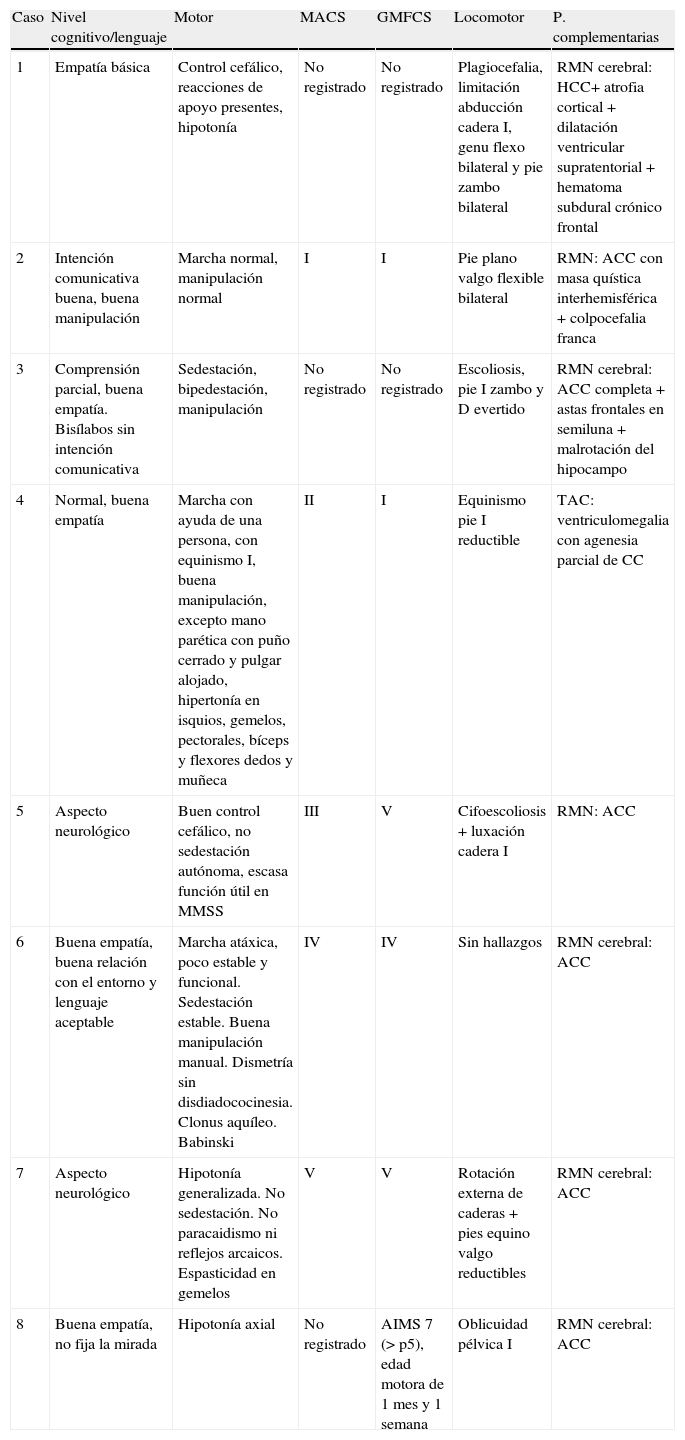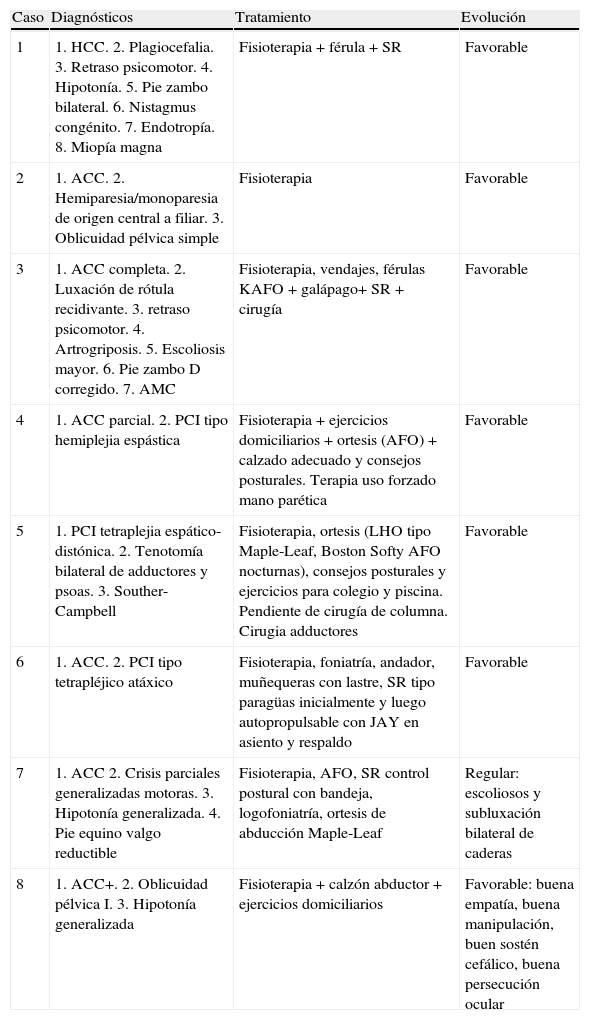La agenesia del cuerpo calloso (ACC) supone una desconexión interhemisférica por falta de formación de dicha estructura en el desarrollo embrionario. Prevalencia: 0,3-0,5% en población general y 2,3% en personas con discapacidad. Se asocia a prematuridad y edad materna avanzada. Clínica muy variable.Puede confirmarse con RMN. Nuestro objetivo es determinar: 1) la correlación entre las anomalías del CC en neuroimagen y en la clínica y 2) averiguar factores influyentes en estas diferencias.
Material y métodosEstudio retrospectivo (15 años) de casos de ACC de una Unidad de Rehabilitación Infantil. Los datos epidemiológicos, clínicos e imaginológicos recogidos se confrontaron entre sí y se compararon con la bibliografía.
ResultadosEl 75% eran mujeres. La edad media de la primera y última revisión, fue 1,8 y 10,7 años, respectivamente. Los motivos de consulta principales fueron alteraciones ortopédicas o neuromotoras. No existían antecedentes obstétricos de interés en el 75%. En la clínica, encontramos: retraso psicomotor (37%), alteración del lenguaje (31%), dificultad para marcha o la manipulación (57%), malformaciones axiales (25%). Las patologías periféricas predominantes se dieron en pies y caderas. La prueba complementaria más frecuentemente solicitada fue la RMN. El 75% asociaba otras malformaciones cerebrales.Tratamiento prescrito: fisioterapia (100%), férulas (75%), silla de ruedas (50%), tratamiento logopédico y/o quirúrgico (25%). Evolución: 87% favorable.
Conclusiones1) La RMN puede ayudar al diagnóstico inicial y despistaje de malformaciones asociadas, pero no siempre se correlaciona con la clínica y no puede servirnos de medidor pronóstico. 2) La ACC puede ser grave a nivel neurológico, psicológico y motriz, sin embargo, en ocasiones cabe esperar una evolución favorable.
The agenesis of the corpus callosum (ACC) implies an interhemispheric disconnection due to the lack of formation of said structure in the embryo development. Prevalence: 0.3-0.5% in the general population and 2.3% on in persons with disability. It is associated to prematurity and older maternal age. The clinical variable varies greatly and can be confirmed with the MRI. Our objective has been to determine 1) the correlation between abnormalities in neuroimaging and in the clinical features and 2) to discover the factors influencing these differences.
Material and methodsA retrospective study (15 years) of cases of ACC in a Children's Rehabilitation Unit. The epidemiological, clinical and imaging data collected were compared to each other and with the literature.
ResultsA total of 75% were women. Average age of the first and last check-up was 1.8 and 10.7 years, respectively. The main reasons of the consultations were orthopedic or neuro-motor disorders. There were no obstetric backgrounds of interest (75%). At the clinical features, we found psychomotor retardation (37%), language disturbance (31%), difficulty to walk or with manual handling (57%), axial malformations (25%). The predominant peripheral neuropathy occurred in feet and hips. The most frequently requested complementary test was an MRI. A total of 75% were associated with other brain malformations. Treatment prescribed: physiotherapy (100%), splints (75%), wheelchair (50%), speech therapy treatment and/or surgery (25%). Evolution: 87% favorable.
Conclusions1) MRI can help the initial diagnosis and screening of associated malformations, but does not always correlate with the clinical features and cannot be used by us to gauge prognosis. 2) The ACC may be serious on the neurological, psychological and motor level, however sometimes we can expect a favorable outcome.
Artículo
Comprando el artículo el PDF del mismo podrá ser descargado
Precio 19,34 €
Comprar ahora














